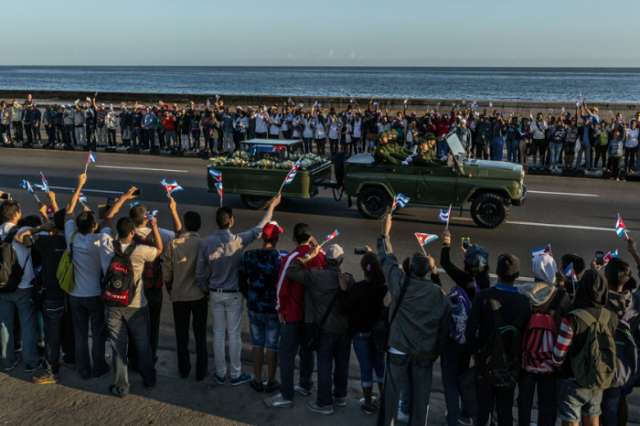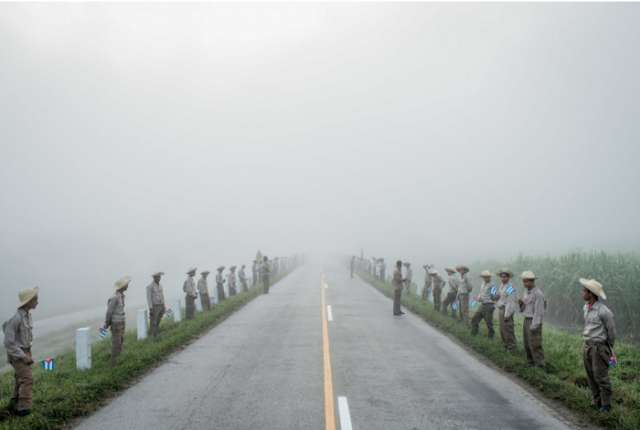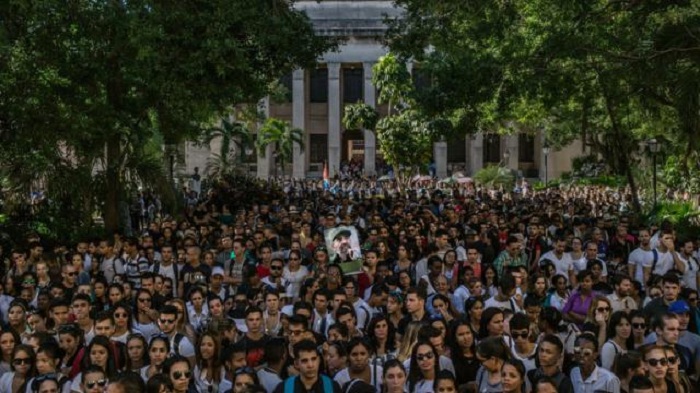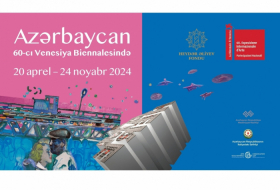Havana, by nature, is a noisy place. Honking, chatter and pulsing music are just three strands of the city’s braided soundtrack. But the death of Mr. Castro brought an eerie silence.
The government banned drinking, partying and loud music, leaving the city on mute, bereft of its melody and verve.
For many Cubans, the death of Mr. Castro felt like that of a father — one with whom they had a complicated relationship. In his nearly 50 years leading the nation, he brought much to Cuba, including free health care and education, but he also oversaw economic deprivation and stifled freedom.

A carriage carried Mr. Castro’s ashes in Havana. Credit Mauricio Lima for The New York Times

Sorrow in Santa Clara as Mr. Castro’s ashes passed by. Credit Tomas Munita for The New York Times

Trucks carried students home after the carriage passed. Credit Tomas Munita for The New York Times

A ubiquitous image, here in a hair salon in Havana. Credit Tomas Munita for The New York Times
The contradiction of Mr. Castro’s Cuba persisted in his passing. Across the generations, there were tears and genuine sorrow. Others hardly mourned at all, keeping quiet all the same, out of fear, respect or a sense of social obligation.
In death, as in life, Mr. Castro demanded reverence.
On Wednesday, Mr. Castro’s ashes were taken into the countryside, on a route that retraced, in reverse, the steps of the revolution he led in 1959. Towns and villages along the route were emptied of residents as caravans of flatbed trucks carted thousands to catch a glimpse of Mr. Castro’s remains.

Waiting along the road to Santiago de Cuba at dawn for Fidel Castro’s caravan. Credit Tomas Munita for The New York Times

Cubans returned to their villages after the procession. Credit Tomas Munita for The New York Times

Waiting for the procession to pass by in Bayamo. Credit Tomas Munita for The New York Times

Tears as the caravan passed in Santa Clara. Credit Tomas Munita for The New York Times

People shouted slogans as they waited at Revolution Plaza in Santiago. Credit Mauricio Lima for The New York Times
The residents rose before dawn and retired after dark, forming surreal lines of order. Their faces were fixed in reverence.
In rural Cuba, there was no trace of the cynicism or state pressure that was on display in Havana.
The revolution delivered to the rural poor the benefits of cities, like doctors and teachers. Schoolgirls and weathered farmers shared an unscripted devotion born of admiration for Mr. Castro’s ideals and values, and for the self-respect he gave his people.
On Saturday, in Revolution Plaza in Santiago de Cuba, where his revolution began, the ambience was one of genuine warmth. People were enjoying one another, their friends and families, a human connection that predated the distraction of selfies and social media. A distinctly Cuban togetherness unbroken by technology.
Mr. Castro was buried in the city Sunday morning, the revolutionary interred in the heartland of his revolution. Compatriots from his earliest days hobbled to attend, as did students, soldiers and officials. As the procession finished the final mile from the plaza to the cemetery, a stillness presided over the crowd.
But the refrain of the journey was the same. What had been carried in the chants of Cubans and on their shirts and banners now emerged without a word: Yo Soy Fidel.

A basketball court in Havana. Credit Tomas Munita for The New York Times

A vegetable market in Havana. Credit Tomas Munita for The New York Times

Mourners carried photos of Mr. Castro. Credit Tomas Munita for The New York Times

Mr. Castro’s caravan arriving in Santiago at the end of the journey. Credit Tomas Munita for The New York Times

Mourners waiting for the final ceremony at Revolution Plaza in Santiago. Credit Tomas Munita for The New York Times

A man resting at the end of the day in Old Havana. Credit Tomas Munita for The New York Times
















































